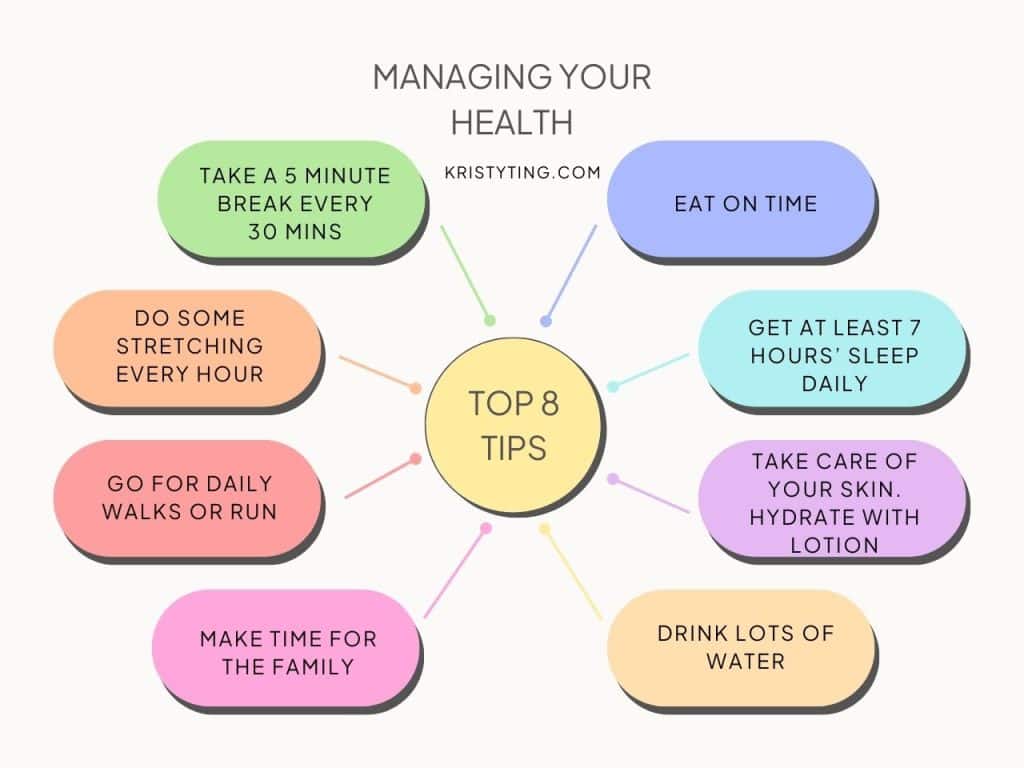This post may contain affiliate links. If you use these links to buy something we may earn a commission at no extra cost to you. Thank you for your support!
When I started working from home, office setup was honestly never one of my concerns. I had no problem with a chair and a computer on a table. That was good enough for me. However as time went on, I started realizing that I was spending a serious number of hours being confined to a chair, and slowly started to make changes to what would eventually be my home office setup.
So, what exactly does the best work from home computer setup entail? Well, it depends on your specific needs and preferences. You don’t need to get everything at once, really. Some key components that you want to consider, though, include
– a reliable computer,
– a comfortable and ergonomic desk and chair,
– a high-quality monitor or dual monitors, a good webcam and microphone for video conferencing,
– and a reliable internet connection.
Voila! The end.
Just kidding.
Best Work from Home Computer Setup: The Fundamentals

As a remote worker, having a dedicated home office space is essential to maintain productivity and separate work from home life. Setting up a perfect workspace for work-from-home (WFH) requires careful consideration of various factors, including the right equipment, furniture, and layout.
To create an ideal work-from-home setup, consider the following essentials:
Desk and Chair
An ergonomic chair with adjustable height, lumbar support, and armrests can help prevent back pain and improve posture. A desk with enough space for a computer, keyboard, and other essential items is also necessary.
The keyword here is SPACE. Please get a wide table you can use to put your water bottle, phone, phone holder, some reference books, tons of pens, notebooks, snacks, and everything in between – and still allow you to find your mouse easily.
Computer and Monitor
A reliable computer and monitor are necessary to work efficiently from home. A laptop or desktop with adequate processing power and storage is necessary to handle work tasks. A monitor with a large screen size and high resolution can improve productivity and reduce eye strain.
Talking about eye strain, it’s always a good idea to turn your PC’s night light on throughout the day if you’re going to be spending hours on it. I have mine perpetually on and adjusted so my screen isn’t too yellow.
As an extra note, please do go for a mechanical keyboard. It may be more traditional, but definitely more lasting and durable compared to butterfly or scissor keyboards.
Webcam and Microphone
Video conferencing has become an essential part of remote work. A high-quality webcam and microphone are necessary to communicate effectively with colleagues and clients. A webcam with 1080p resolution and a microphone with noise-cancellation features can help create a professional video conferencing experience.
I personally use a Canon EOS 90D DSLR and it works perfectly for me – my background looks great and professional in all my video calls. In the first 2 years, though – I used a Logitech C922 Pro webcam (which cost me around $40) and I was pretty happy with it – so if you’re on a budget that’s what I’d recommend (unless you’re on a laptop – then you use the webcam on your laptop!)
Lighting and Soundproofing
Good lighting and soundproofing can help create a distraction-free workspace. A well-lit room with natural light can improve mood and reduce eye strain. Soundproofing can help reduce noise from outside, creating a quiet and peaceful environment to work.
I work in an open area in the house so soundproofing isn’t really an option but I’ve pretty much gotten used to it. I ensure lights are fully on when I’m working on my laptop on the dining room table – but when I’m upstairs on my desktop, curtains are typically open but adjusted to allow ample sunlight without causing too much glare.
Internet Connection
A reliable and fast internet connection is necessary for remote work. A stable internet connection can help ensure smooth video conferencing, file sharing, and other online tasks. A wired connection is often more reliable than a wireless one, but a high-speed router can also improve internet speed and stability.
For remote workers, setting up a work-from-home office requires careful consideration of various factors. By investing in the right equipment, furniture, and layout, you can create a productive and comfortable workspace to work efficiently from home.
Choosing the Right Equipment
When it comes to setting up your work from home computer, choosing the right equipment is really important. You don’t need to spend a ton, but you have to spend just enough to get sturdy, reliable equipment to last you the next 6-7 years at least.
In this section, I will go over some of the most important pieces of equipment to consider, including the computer itself, monitor, keyboard, and mouse.
Choosing a Computer
When choosing a computer for your work from home setup, it’s important to consider your needs. If you’re primarily working with documents or spreadsheets, a laptop with an Intel Core processor may be sufficient. However, if you’re working with more demanding programs like graphic design software or video editing tools, a desktop computer with a more powerful processor may be necessary.
My computer specs? Dell XPS 8940 with tons of space for me to save my design work.
Importance of a Good Monitor
You can use the standard monitor that comes with the desktop you ordered. However, a larger monitor or a second screen can help increase productivity by allowing you to view multiple windows or applications simultaneously.
That’s what I have been using for a few years now – my monitor is 32” in size – the S3221QS.
If you’re using a laptop, consider investing in an external monitor or a portable monitor that can be easily connected to your laptop.
The Role of Keyboards and Mice
Using a mechanical keyboard and a wireless mouse can help improve your typing speed and accuracy. Additionally, an ergonomic keyboard and mouse can help prevent strain and injury to your hands and wrists. If you’re working with a laptop, consider investing in a laptop stand to elevate your screen and a wireless keyboard and mouse for a more comfortable and ergonomic setup.
Overall, choosing the right equipment for your work from home setup can help increase productivity and prevent strain and injury. Consider investing in a larger monitor, mechanical keyboards, and wireless mouse for a more comfortable and efficient work experience.
Creating a Comfortable Workspace
When working from home, it is important to create a comfortable and ergonomic workspace that promotes productivity and efficiency. Here are some tips on how to create the best home office setup.
Selecting the Best Desk
The desk is the centerpiece of any home office setup. When selecting the best desk, consider the size of your work environment and the amount of desk space you require. A dedicated space for your own home office is a great way to ensure you have enough room for your desk setup. If you don’t have enough space for a full-sized office desk, a kitchen table or a smaller desk can be a great addition to your wfh setup.
The Need for an Ergonomic Chair
An ergonomic office chair is essential for maintaining good posture and avoiding back pain. Look for a chair with lumbar support and adjustable height and tilt. A great way to find the best ergonomic chair is to try it out in person before purchasing. If you are on a budget, there are many affordable options available that still offer good lumbar support and adjustability.
Benefits of Adjustable Standing Desks
An adjustable standing desk is a great way to switch between sitting and standing throughout the day. This can help improve circulation and reduce the risk of developing back pain. When selecting an adjustable standing desk, consider the size of your workspace and the weight capacity of the desk. A great option is the SHW Electric Height Adjustable Computer Desk, which is small and inexpensive for a standing desk that still offers motorized height adjustments.
The one I use? TT Racing’s adjustable desk. It’s not too expensive, and REALLY helps when I feel numb from sitting. I get to stand up and stretch my legs while being on camera or just typing.
In addition to a desk, chair, and adjustable standing desk, other items to consider for your ideal home office setup include a desk lamp, a Dell Inspiron computer, and other accessories that can help create a comfortable and productive work environment.
By following these tips, you can create a comfortable and ergonomic workspace that promotes productivity and efficiency when working from home.
Managing Your Environment
When working from home, it’s important to create an environment that is conducive to productivity. This means managing noise, ensuring proper lighting, and maintaining good air quality.
Managing Noise
External noise can be a major distraction when working from home. If you live in a noisy area or have family members who make noise, consider investing in noise-cancelling headphones. Alternatively, you can try working in a quieter part of your home, like a spare bedroom or home office. If you need to take calls or participate in video conferences, make sure the background noise is minimized. If necessary, consider working from a coffee shop or other location with less noise.
Proper Lighting
This is more of common sense. We try to reduce glare from our monitors as much as we can. Too much glare – earlier eyesight deterioration and aging.
How do we reduce glare? Ensure there is enough natural lighting.
Try to set up your workspace near a window. If this is not possible, invest in a desk lamp with adjustable brightness levels. Position your screen at eye level to avoid eye strain and glare. If you’re using an external keyboard, make sure it has a backlight so you can type comfortably in low-light conditions.
Air Quality
This is not really a must-have, but something you’d want as you’re working long hours or racing against a deadline. An open window, a cool breeze, fresh air and some trees in view can work wonders for your mental health.
If you’re working in a room with poor ventilation, consider investing in an air purifier. This will help remove pollutants and allergens from the air, making it easier to breathe. You can also keep plants in your workspace. Not only do plants help purify the air, but they also add a pop of color to your remote work setup.
Optimizing for Productivity

As someone who has been working from home for a while now, I know that having the right setup can make all the difference in terms of productivity. Here are a few tips to help you optimize your home office setup:
Organizing Your Workday
One of the most important things you can do to stay productive while working from home is to create a schedule and stick to it. This means setting specific work hours and creating a to-do list for each day.
I find it helpful to use a task management tool like Trello or Asana to keep track of my daily tasks. These tools allow you to create different boards and lists, which can help you organize your workday and stay on track. My favorites though, are Notion and ClickUp – both are very user-friendly and keeps my clients’ files very organized, allowing me to always stay on top and never miss any deadlines.
Maintaining Work-Life Balance
When you work from home, it can be easy to blur the lines between work and personal time. To avoid burnout, it’s important to maintain a healthy work-life balance.
One way to do this is to create a designated workspace in your home. This can help you mentally separate your work life from your personal life. Additionally, try to take regular breaks throughout the day to stretch, move your body, and clear your mind.
I do daily evening walks around the house for about 45 minutes. It can get mundane so try to switch up your routine once in a while. Either walk elsewhere at a different park, or go window shopping at a mall. In any case, all the time away from the computer helps to clear your head and allow you to perform better.
Staying Healthy While Working from Home
Working from home can also take a toll on your physical health. To avoid issues like eye strain and poor posture, invest in a good ergonomic chair and make sure your computer monitor is at eye level.
Another way to stay healthy while working from home is to take advantage of the greater flexibility it offers. Use your breaks to take a walk outside or do a quick workout. And don’t forget to stay hydrated throughout the day!
Overall, optimizing your home office setup for productivity requires a combination of good organization, work-life balance, and attention to your physical and mental health. By following these tips and investing in the right home office essentials, you can create a work experience that is both comfortable and efficient.
Special Considerations for Different Professions
As a content creator, having a powerful computer is essential for getting the job done. When it comes to work from home computer setups, there are a few things that you should consider.
Setup for Content Creators
First and foremost, battery life is crucial. You don’t want to be tethered to a power outlet all day long. A laptop with a long battery life is a great option for content creators who need to work on the go. Additionally, consider a computer with a high-quality microphone and audio output for recording voiceovers and podcasts.
For everyday use, a computer with a fast processor and plenty of RAM is a must. This will ensure that you can smoothly run multiple applications at once, such as Adobe Premiere Pro or Final Cut Pro. When it comes to storage, consider investing in an external hard drive for backing up large files.
Setup for Graphic Designers
For graphic designers, a large and high-quality monitor is a must. An ultrawide monitor can be a great option for viewing multiple windows at once. Additionally, consider a computer with a powerful graphics card to handle large files and complex designs.
When it comes to audio quality, a good set of speakers or headphones is essential for accurately hearing the details in your designs. For storage, consider investing in a solid-state drive (SSD) for faster read and write speeds.
Setup for Software Developers
As a software developer, having a fast and reliable computer is essential for compiling code and running virtual machines. A computer with a fast processor and plenty of RAM is a must. Additionally, consider investing in a second monitor for increased productivity.
When it comes to storage, consider investing in a solid-state drive (SSD) for faster read and write speeds. This is especially important when working with large files or running virtual machines. Finally, make sure that your computer has a good set of speakers or headphones for listening to music or attending virtual meetings.
In summary, when setting up your work from home computer, it’s important to consider your profession and specific needs. Whether you’re a content creator, graphic designer, or software developer, there are certain features and specifications that will make your workday more productive and efficient.
How You Can Set up a Home Office for Small Space?

As someone who has worked from home for a long time, I know how important it is to have a good home office setup. But what if you don’t have a lot of space? Here are some tips for setting up a home office in a small space:
- Find a dedicated space: The first thing you need to do is find a space in your home that you can dedicate to your home office. This could be a corner of your living room, a small nook in your bedroom, or even a closet. The key is to find a space that you can make your own and that you can work in comfortably.
- Invest in a good chair: When you’re working from home, you’re going to be sitting for long periods of time, so it’s important to invest in a good chair that provides both lumbar support and comfort. Look for an ergonomic chair that can be adjusted to your body and your workspace.
- Get creative with your desk: If you don’t have a lot of space, you’ll need to get creative with your desk setup. Look for a desk that is compact and has enough space for your computer and any other essentials you need. Alternatively, consider using a laptop stand or an adjustable standing desk.
- Make use of natural lighting: Natural lighting is a great way to brighten up a small space and make it feel more open. Try to set up your desk near a window so that you can take advantage of the natural light.
- Eliminate background noise: If you’re working from home, you’re going to be dealing with a lot of background noise. To eliminate distractions, consider investing in noise-canceling headphones or an air purifier.
- Keep your desk clean and organized: When you’re working in a small space, it’s important to keep your desk clean and organized. Use a desk lamp to provide additional lighting and keep your desk clutter-free by using a to-do list and a filing system.
- Consider a portable monitor: If you need a larger screen for work or for content creation, consider investing in a portable monitor that you can easily move around your home.
- Make use of vertical space: When you’re working in a small space, it’s important to make use of vertical space. Consider installing floating shelves or using a wall-mounted desk to free up valuable floor space.
- Choose a color scheme: Finally, consider choosing a color scheme that will help you stay focused and productive. Opt for colors that are calming and soothing, such as blues and greens, or choose a monochromatic color scheme to keep things simple and streamlined.
By following these tips, you can set up a home office in a small space that is both functional and comfortable. Remember, the key is to find a space that you can make your own and that you can work in comfortably.
How To Budget For Your Home Office
When it comes to setting up a home office, budgeting is an important step to consider. I know that not everyone has an unlimited budget to create their ideal home office setup, but there are ways to make the most of what you have. Here are some tips on how to budget for your home office.
Assess Your Needs
Before you start buying anything, assess your needs. What kind of work will you be doing? What equipment do you already have? What do you need to buy? Make a list of everything you need, and prioritize the items based on importance.
Create a Budget
Once you have your list of needs, create a budget. Determine how much you can afford to spend on your home office setup. Be realistic and don’t overspend. Remember, you can always upgrade later.
Shop Around
Don’t buy the first thing you see. Shop around and compare prices. Look for deals and discounts. Check out different brands and read reviews to find the best value for your money.
Consider Alternatives
If you can’t afford an ergonomic chair or a dedicated office desk, consider alternatives. For example, you can use a laptop stand or a wireless keyboard to improve your work environment. You can also work from a coffee shop or a library if you don’t have a dedicated space at home.
Table of Estimated Costs
| Item | Brand | Estimated Cost |
| Ergonomic Chair | Autonomous ErgoChair Pro | $350 – $500 |
| Office Desk | IKEA Bekant | $200 – $500 |
| Computer Monitor | Dell Ultrasharp U2719DX | $300 – $500 |
| Laptop Stand | Rain Design mStand | $50 – $100 |
| External Keyboard | Logitech K810 | $50 – $100 |
| Wireless Mouse | Logitech MX Master | $50 – $100 |
| Portable Monitor | Duex Plus | $200 – $300 |
| Noise-Canceling Headphones | Bose QuietComfort 35 II | $300 – $400 |
| Air Purifier | Coway AP-1512HH Mighty | $200 – $300 |
As you can see from the table above, the estimated costs of setting up a home office can vary depending on the brand and quality of the items you choose. However, with some research and careful budgeting, you can create a comfortable and productive work environment without breaking the bank.
Frequently Asked Questions
What is the best way to set up a productive home office?
To set up a productive home office, it’s important to create a dedicated workspace that is free from distractions. Find a quiet area in your home and set up a desk and chair that are comfortable and ergonomic. Make sure you have good lighting and invest in noise-cancelling headphones if necessary. Keep your workspace organized and free from clutter to minimize distractions.
How can I create a comfortable and ergonomic workspace?
Creating a comfortable and ergonomic workspace is essential for maintaining good posture and preventing strain and injury. Invest in a good quality chair that provides proper lumbar support and can be adjusted to your height. Ensure that your computer monitor is at eye level and that your keyboard and mouse are at the correct height to prevent strain on your wrists. Take regular breaks to stretch and move around to prevent stiffness and discomfort.
What are some essential items for a work from home setup?
Some essential items for a work from home setup include a reliable laptop or desktop computer, a comfortable and ergonomic chair, a good quality monitor, a keyboard and mouse, noise-cancelling headphones, and a reliable internet connection. You may also want to invest in a printer, scanner, and other office supplies depending on your job requirements.
How can I optimize my laptop and monitor for work?
To optimize your laptop and monitor for work, ensure that your display settings are set to the correct resolution and refresh rate for your monitor. Adjust the brightness and contrast settings to reduce eye strain. Use a docking station or external keyboard and mouse to prevent strain on your wrists and neck. Keep your computer updated with the latest software and security patches to ensure optimal performance.
What are some creative desk setup ideas for working from home?
Some creative desk setup ideas for working from home include using a standing desk or a treadmill desk to promote movement and reduce sedentary behavior. You can also add plants, artwork, or other decorative elements to personalize your workspace and make it more inviting. Consider using a whiteboard or bulletin board to keep track of your tasks and deadlines.
What are some tips for maintaining focus and productivity while working from home?
To maintain focus and productivity while working from home, establish a routine and stick to a regular schedule. Take breaks and move around regularly to prevent burnout and fatigue. Use productivity tools such as time-tracking apps or Pomodoro timers to help you stay on task. Minimize distractions by turning off notifications and setting boundaries with family members or roommates.





